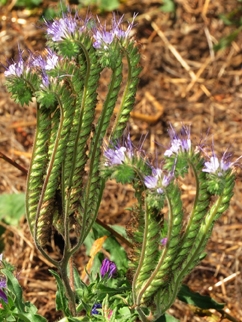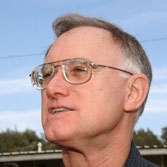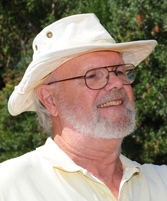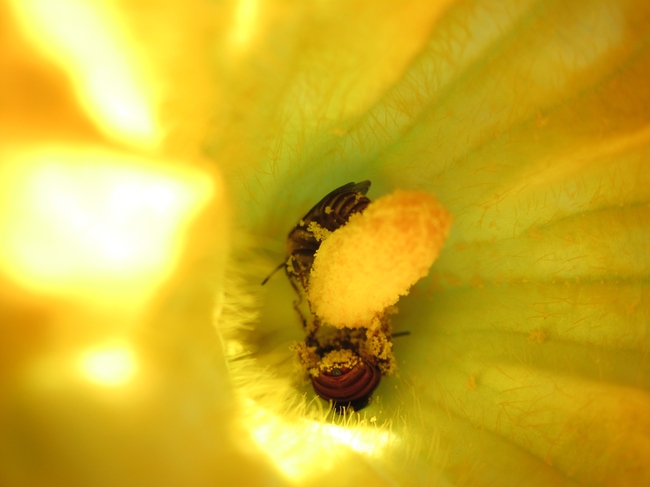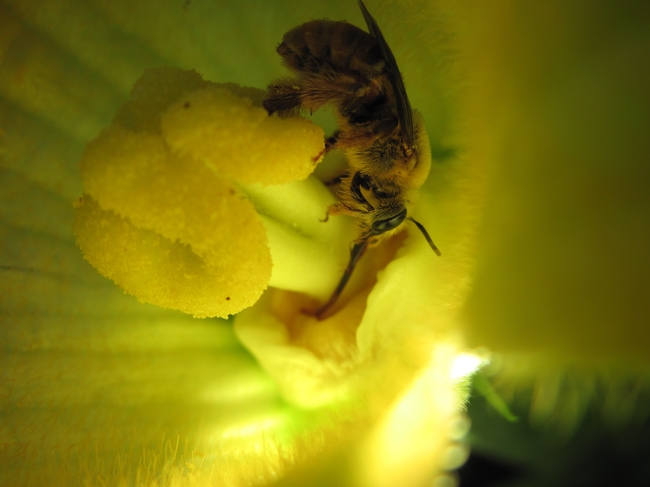Posts Tagged: pollinators
Attracting Pollinators to Your Garden
"How to Attract and Maintain Pollinators in Your Garden." That's the title of a new publication by the University of California Agriculture and...
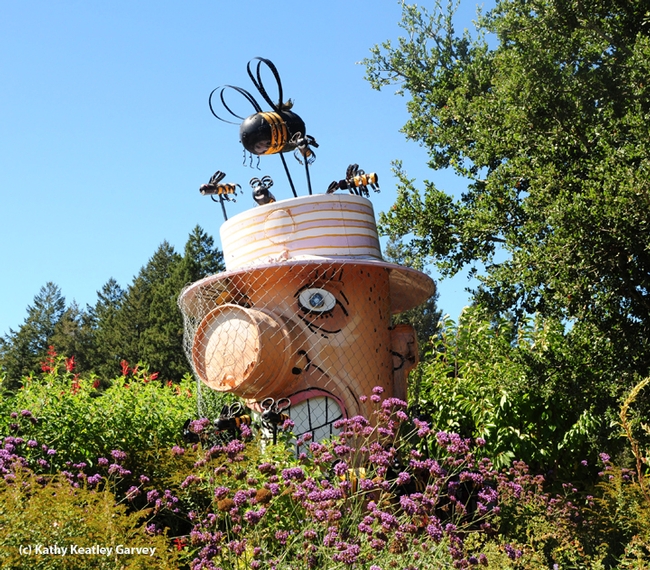
A sculpture of Bernard the Beekeeper graces the entrance to Melissa's Garden, Healdsburg. (Photo by Kathy Keatley Garvey)
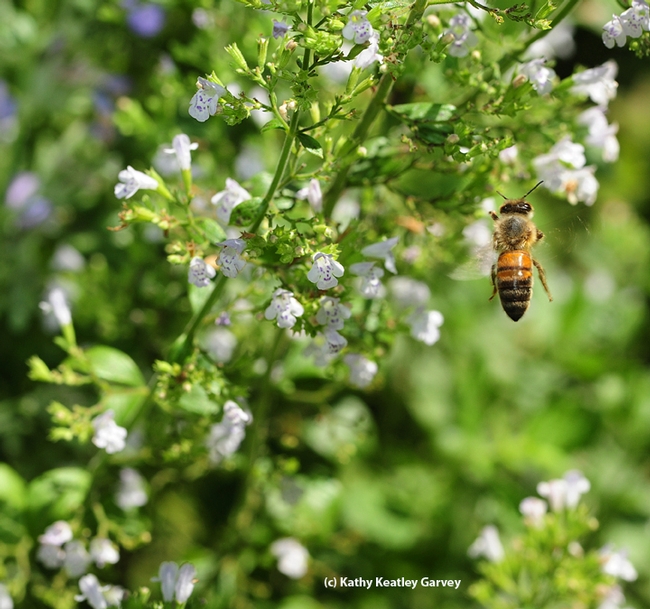
A honey bee foraging in Melissa's Garden. (Photo by Kathy Keatley Garvey)
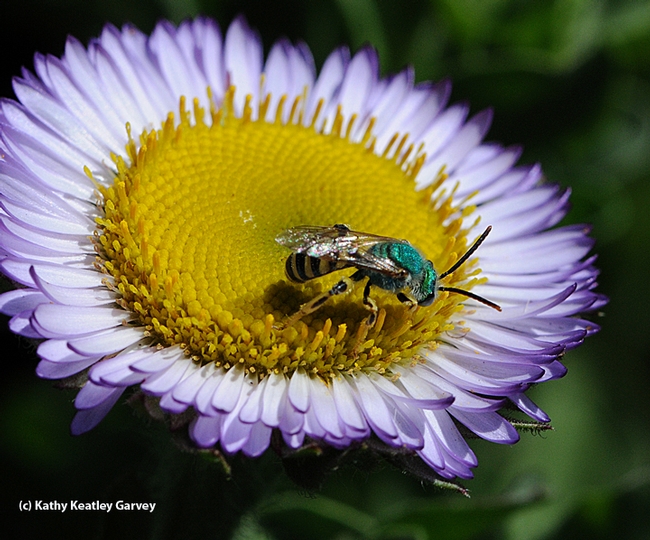
A metallic green sweat bee on a seaside daisy. It is one of some 1600 species of bees in California. (Photo by Kathy Keatley Garvey)
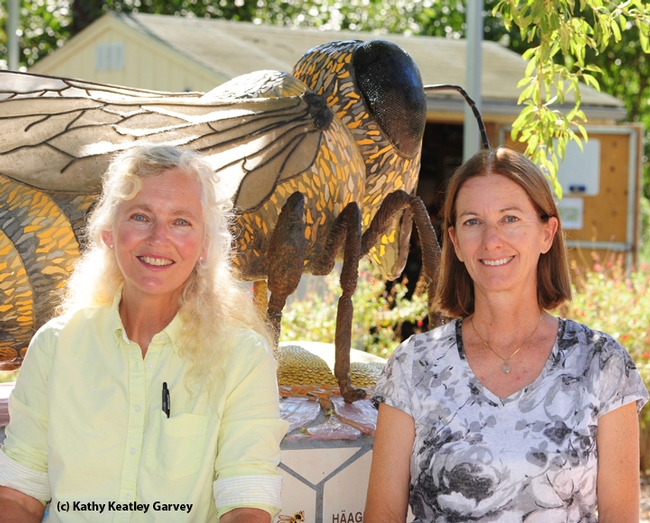
International landscape designer Kate Frey (left) of Hopland and her childhood friend, Rachael Long, Yolo County farm advisor/county director of the UC Cooperative Extension, Woodland on a visit to the Haagen-Dazs Honey Bee Haven, UC Davis, in September. Behind them is the mosaic ceramic bee sculpture created by Donna Billick, co-director of the UC Davis Art/Science Fusion Program. (Photo by Kathy Keatley Garvey)
Honey bees: Should they be banned from native plant restoration areas?
What’s a honey bee to do?
The dwindling resources of pollen and nectar-producing plants in California greatly concern bee scientists and beekeepers, and rightfully so.
But the dwindling resources also greatly concern native pollinator specialists and native plant enthusiasts. Some worry that honey bees, which are non-natives, may be "reducing" or "eliminating" native pollinators through competition for food.
Are they?
Extension apiculturist Eric Mussen of the UC Davis Department of Entomology and Nematology explains that a number of agencies and organizations are cooperating in an effort to "restore" regions of the California Central Valley to their "original state."
“The major emphases are (1) replacing non-native vegetation with native plants and (2) encouraging native animals to return to their former ranges,” Mussen says. "The result has been eviction of beekeepers from apiary locations that have been used for decades as seasonal spots for rebuilding populations following the stresses of commercial pollination or for producing honey."
“While removing this non-native pollinator from an environment may sound rational at first, it may not be the best idea,” Mussen points out. “In most cases, it is not the presence of honey bees that has depressed or eliminated the populations of native pollinators. In fact, no studies have shown that honey bees eliminate native pollinators. In some cases, the populations of native pollinators have been reduced by honey bee competition, but following removal of honey bees the native bees built back to usual levels in a couple years.”
Indeed, in some situations, honey bees can survive, and native pollinators can’t.
“With honey bees, if we provide them with an adequate hive and food sources, they are likely to survive,” Mussen says. “However, native pollinators can be very particular about the environment in which they can exist. If their nesting habitat is disturbed, modified or destroyed, they cannot live in the area, despite an abundance of food plants. In many California locations, it is habitat alteration or destruction, not lack of food, which eliminated the native pollinators.”
When native habitats are compromised, “honey bees may be essential to foster initial re-establishment of native plant populations,” Mussen relates. “Those plants provide food and shelter for wildlife and assist significantly in erosion control. Until the habitat is restored adequately to meet the requirements of native pollinators, it is likely that the presence of honey bees will be much more beneficial than detrimental in keeping the California native plants pollinated and reproducing.”
So, should honey bees be banned from restoration areas?
"No," Mussen says. "Honey bees should be solicited for restoration areas, not banned."
Mussen shares a list of 130 native California plants that are likely to be visited - "and probably pollinated" - by honey bees. They include button bush or button willow, fiddleneck, and California golden poppy. The list is excerpted from Nectar and Pollen Plants of California by G. H. Vansell UC Berkeley, plus personal observations by native pollinator specialist Robbin Thorp, UC Davis emeritus professor of entomology. The list is updated, reflecting information on the CalFlora website and the Jepson Manual of Higher Plants of California.
Thorp, who monitors the Häagen-Dazs Honey Bee Haven, planted in the fall of 2009 on Bee Biology Road, UC Davis, has found more than 80 different species of bees - and counting - in the half-acre bee garden. It's located next to the apiary at the Harry H. Laidlaw Jr. Honey Bee Research Facility.
So honey bees and native bees share the resources.
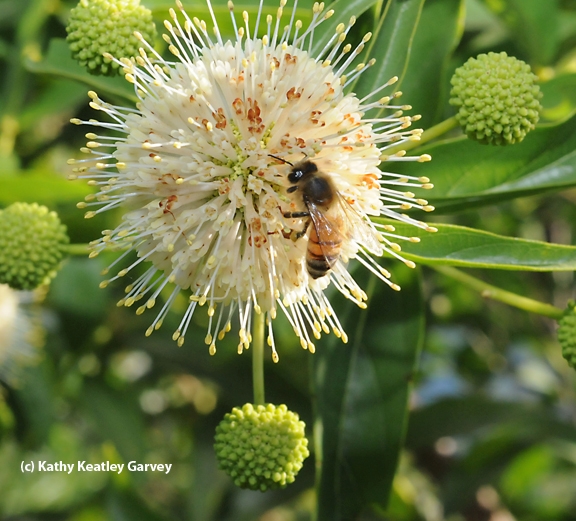
A honey bee foraging on button willow, also known as button bush, Cephalanthus occidentalis. Honey bees on non-natives, and the button bush is a native California plant. (Photo by Kathy Keatley Garvey)
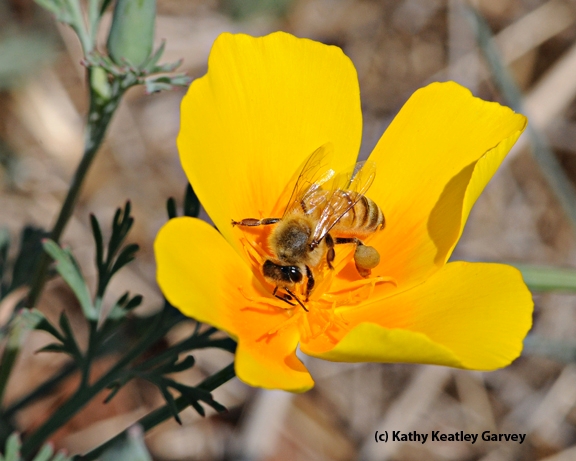
Honey bee visiting California golden poppy, Eschscholzia spp. (Photo by Kathy Keatley Garvey)
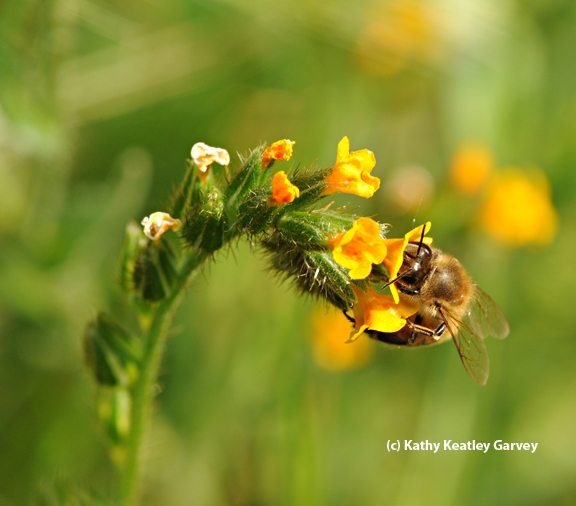
Honey bee foraging on fiddleneck, Amsinckia spp. (Photo by Kathy Keatley Garvey)
For Beginners, a Guide to Pollinators
So many flowers. So many pollinators. So many floral visitors. On every field trip, we see something new and different, such as the male...
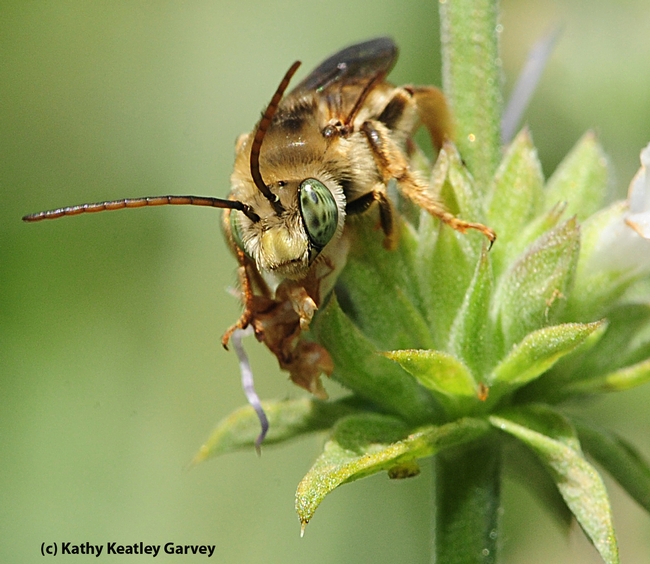
Male long-horned bee, Melissodes communis, on salvia. Identified by Robbin Thorp. (Photo by Kathy Keatley Garvey)
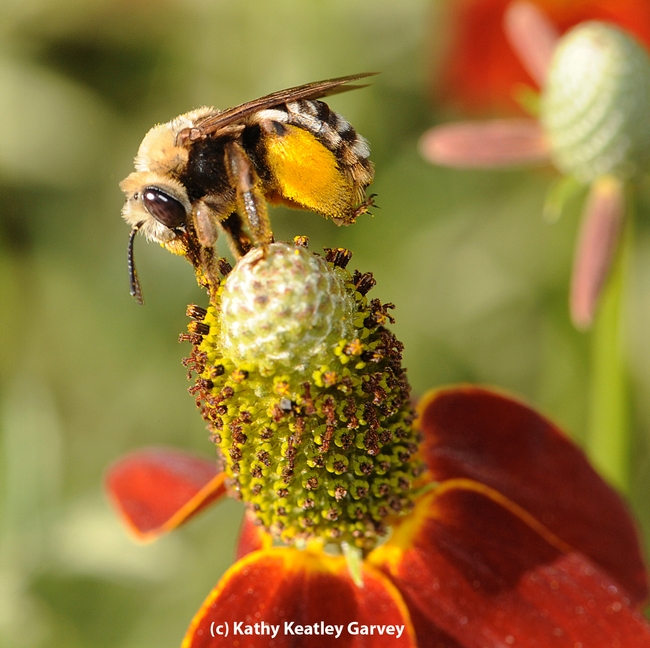
Female sunflower bee, Svastra obliqua expurgata, on Mexican hat flower. Identified by Robbin Thorp. (Photo by Kathy Keatley Garvey)
Watching out for native worker bees
With warm weather and mostly dry skies, some California farmers are prepping their fields for spring planting. On many fields used to grow squash and pumpkins, native squash bees (Peponapis pruinosa), valuable pollinators for squash growers, are nesting in the soil, waiting for spring emergence. With over ten thousand acres of squash and pumpkins grown in California in 2011, the success of pollination covers a lot of ground.
New studies are showing that native bees may be more productive pollinators than honey bees, and that in some cases, the presence of native bees can boost the pollinating potential of commercially produced honey bees. But native bee populations face threats that are not yet fully understood.
For native bee researcher Katharina Ullmann, understanding how these bees will be impacted by the upcoming tillage and other farming practices are big questions that can help farmers make decisions that protect native bee populations in their fields and maximize the benefit farmers see from pollinators. Ullmann was recently awarded a grant from Western SARE (Sustainable Agriculture Research and Education) and the National Science Foundation to fund her doctoral research on how crop rotations and tillage practices affect native squash bee populations.
Her work is part of the Bee Biology lab run by Neal Williams, assistant professor of Entomology at UC Davis and a contributing author to recent studies on the benefits of native bees. Too, Ullmann serves on the Advisory Board to the Agricultural Sustainability Institute at UC Davis, linking field-level entomology to broader sustainability research.
Native squash bees nest 5 to 20 inches deep in the soil, and plowing or disking often disturbs soil as much as 20 inches deep, potentially damaging bee nests. Conservation tillage and no-till practices are increasingly seen as ways to lower fuel use and on-farm emissions from nitrogen and carbon dioxide, as well as decrease water runoff. Protecting native bee populations could potentially be an additional co-benefit to these methods.
I think about native bees as an insurance policy and potentially a yield increaser,” says Ullmann. “Honey bees are important; they’re always going to be important. But it can be beneficial for growers to know if they have crop-pollinating native bees flying around if, for example, honey bee prices spike or if it’s hard for a grower to get the number of honey bee colonies he or she needs.” Too, with new studies highlighting the productivity of native bees (in some cases doubling fruit set compared to honey bees), there is growing incentive to protect nesting grounds.
The results of Ullmann’s tillage study, in coordination with a parallel study on the effect of crop rotation on bee populations, will be turned into a user-friendly web tool for farmers to assess which combination of in-field practices will likely be best for fostering bee populations. “In creating these models of tillage and crop rotation practices, we’re hoping to help farmers find the synergy between different farming practices that yield the greatest benefits,” says Ullmann.
“Not all farmers will change tillage or crop rotation practices just because of bees, but maybe this is another piece of information that farmers can use to make informed management decisions. “Ultimately,” says Ullmann, “my goal is to provide farmers with that opportunity.”
Looking for squash bees on your farm or in your garden? They look similar to honey bees but with fuzzier legs that lift dry pollen from squash blossoms, and male bees have a yellow spot on their face that resembles a nose. But perhaps the easiest way to identify them — gently squeeze a closed squash blossom and wait to hear a buzz. The bee inside is likely a native squash bee, resting up in preparation for more work.
So You Want to Learn About Native Bees...
So you want to learn about native bees... Be sure to attend Robbin Thorp's presentation on "Buzzed for Bees" on Saturday afternoon, Jan. 19 at the...
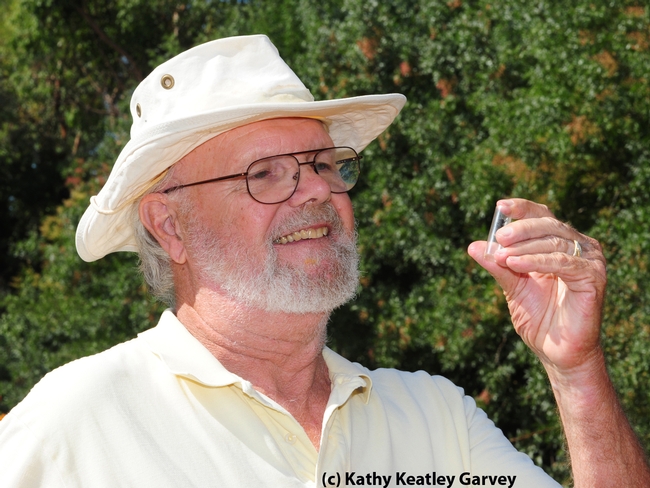
Native pollinator specialist Robbin Thorp, emeritus professor of entomology at UC Davis. (Photo by Kathy Keatley Garvey)
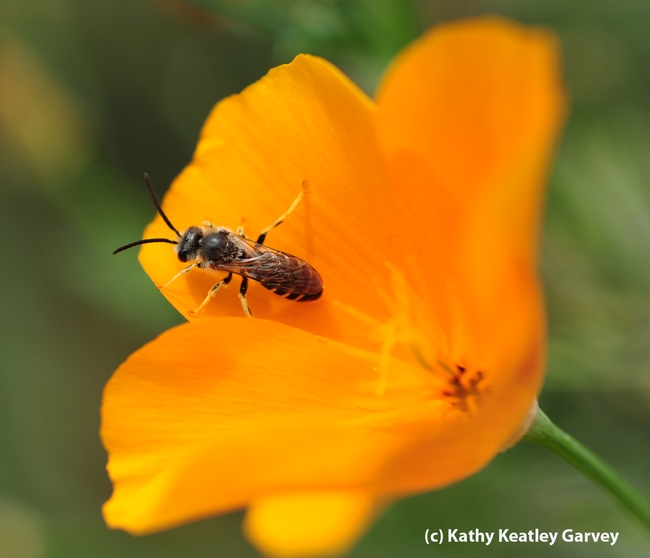
A male sweat bee, Halictus tripartitus, as identified by Robbin Thorp. It is leaving a California golden poppy. (Photo by Kathy Keatley Garvey)


